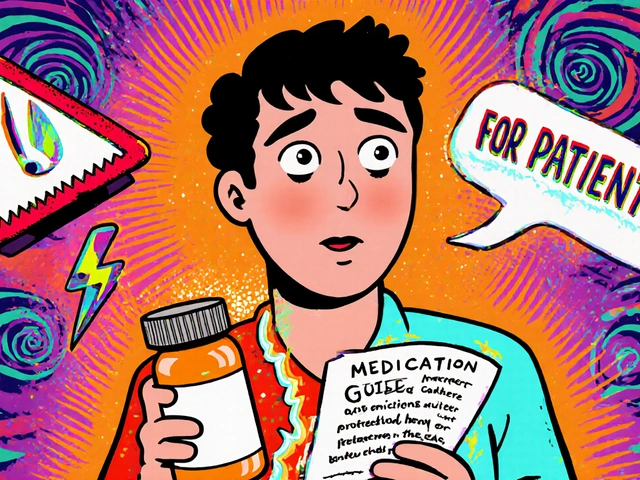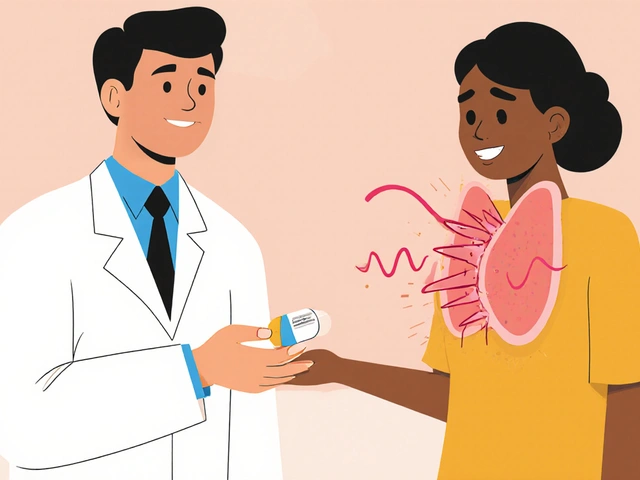How Telemedicine Works for ED Prescriptions
Picture this: less awkward waiting rooms, no paper-thin gowns, and zero small talk with a nervous receptionist. Telemedicine has done a number on the old-school process of getting help for erectile dysfunction (ED prescriptions have never been more accessible). It’s not magic—it’s just digital healthcare stepping up. So, what goes on behind the scenes after you click “Start Consultation” on an ED platform?
First up, registration is typically quick. Most sites will ask for your age, medical history, medications, allergies, and lifestyle habits. It’s all there to make sure you’re safe—no one wants surprises with the heart meds you’re taking for your uncle’s “special steak” diet advice. After the basics, some companies jump straight to a questionnaire, while others throw in a short video chat with a licensed doctor in your state.
Curious what they’ll ask? Questions can be pretty direct: “When did you first notice the problem?” “Are you experiencing any pain?” “Are you able to achieve an erection at all, or is the issue maintaining it?” The topics get real, real fast—but so do the solutions. If you’re approved, your doctor may suggest traditional options—think sildenafil or tadalafil—or newer meds depending on your medical profile. In some cases, the telemedicine doc will advise an in-person visit, especially if your symptoms point to something more complicated than standard ED. This isn’t a sales pitch—it’s about safety first, and responsible telemedicine doesn’t cut corners.
Of course, the privacy factor is stellar. Plenty of guys feel a weight lifted when they can talk to a doctor from the privacy of home, maybe in their favorite sweatpants. The stigma melts away, and that’s not a small thing. Some platforms even have apps that let you message your provider after the initial consult, so follow-ups aren’t a hassle.
But what if you’re worried about sensitive data leaking? Solid platforms (and the reputable ones are easy to spot) encrypt personal info and follow strict HIPAA rules, the same privacy standards your local clinic lives by. Pay attention to trust badges, verified licenses, and user reviews to dodge shady sites. If you feel creeped out, trust your gut and exit.
And let’s clear up a myth: not all ED scripts come via pills. Some doctors suggest therapy, lifestyle changes, or recommend vacuum devices or injectable meds if that’s what’s right for your story. The virtual doc’s job isn’t just to push a prescription out the door; it’s to find what actually works for you—no checklist medicine here. Adelaide would say this openness is one thing she appreciates across the board in digital care.
There’s also the question of state laws. U.S. telemedicine rules can be tricky—prescribing is only allowed if your provider is licensed in your state, even if you’re just across the border in Georgia or North Carolina. Double check that your online provider covers Charleston, or wherever you’re tuning in from. This keeps your prescription legit and protects you in case anything goes sideways.
This digital shift isn’t just about convenience—it’s about giving control back to the patient. Whether you’re tech-savvy or hardly ever check your email, the technology is built to be easy. If you’ve got internet and 15 minutes, you can get real answers. That’s the new standard, and once you see how well it works, the traditional waiting room feels instantly outdated.
One last tip: be honest during your consult. Withholding info can turn a simple fix into a risky scenario. Your provider isn’t judging you—they want the safest and simplest solution, which only happens when the story is clear from the beginning.
Breaking Down the Costs: What Will You Actually Pay?
No one likes sticker shock—especially when you’re tackling something as personal as ED treatment. Telemedicine for ED prescriptions isn’t as expensive as you might think, but there’s a wide range. Instead of guessing, let’s nail down the numbers so you’re not surprised by the final bill.
The first piece of the puzzle: the online consultation fee. On average, you’re looking at $20 to $90, depending on the platform and whether you connect via video or just a web questionnaire. Some subscription platforms wrap consults into a monthly fee, so you’ll see plans starting at $20/month with ongoing support and follow-ups. Pay-as-you-go sites may charge separately for each visit.
The cost of the pills themselves is the main variable. The generic version of Viagra (sildenafil citrate) often clocks in at $2 to $10 per 100mg tablet, but this fluctuates based on where you order, the pharmacy, and whether you’re using insurance. Tadalafil (the generic of Cialis) tends to cost a touch more—think $3 to $14 per pill. Fancy packaging and white-label telehealth brands can drive up the price, usually for the convenience of home delivery or a snazzy, discreet box with your first name printed on it (though, to be fair, some guys absolutely love the touch).
Going the insurance route? Not all plans cover ED meds, and insurance rarely covers the online consult itself. If your plan does pitch in, you could see costs drop to as little as $5 per script—otherwise, you’re looking at out-of-pocket prices. A good move is checking the platform’s FAQ to see if they help submit claims for you or link to local pharmacies for insurance billing.
If you want to save money, ask about generics. They’re just as effective as brand names without the big pharma markup. Some bulk-buy sites or telemedicine programs offer discounts for 3- or 6-month supplies. Plenty of platforms post price charts up front, but always ask for the per-pill breakdown so you know what you’re getting into.
Shipping is often free, but not always. There’s usually an express option if you’re in a rush and willing to pay a bit more. Standard delivery ranges from 2 to 7 business days, though bad weather (plenty of that in the South) or supply chain hiccups can slow things down. Some companies will deliver to a local pharmacy for pickup, if you’d rather avoid shipped packages at your front porch. If privacy matters to you, look for “discreet packaging” options.
Some recent studies found that telemedicine pricing for ED meds can be 40%-60% less than what you’ll get at a brick-and-mortar chain pharmacy, especially in regions where walk-in clinics tack on overhead costs. And if you visit coupon sites or use platform promotions, that cost difference can get even sweeter.
Just be on guard for bait-and-switch pricing: if the website’s promising $1 pills and nothing else, read the fine print. Some sites rope you in with a teaser price only to pile on “processing” fees that bring your monthly total right back up to the usual average, or higher. Transparency matters—if the numbers feel fuzzy, ask for itemized estimates before you hit checkout.
To make it easy to compare, here’s a handy breakdown for what you might pay with popular telemedicine providers:
| Provider | Consultation Fee | Generic Viagra (10 pills) | Shipping |
|---|---|---|---|
| Roman | $15-$25 | $34-$68 | Free |
| Hims | $39 (first visit) | $30-$60 | Free |
| BlueChew | $20 (monthly) | $50-$100 (chewables) | Free |
| Local Pharmacy | $0* | $80-$120 | N/A |
(*Assumes you already have a script from your local doctor.)

What to Expect During Virtual Consultations
You might imagine a stiff, awkward video call, but most online ED prescription consults are nothing like your boss’s Monday meeting. It’s usually relaxed, quick, and refreshingly honest. If you’ve never done this before, knowing what’s coming can take the edge off.
After settling in at your laptop (or sometimes even your phone), you start by filling out some forms. You’ll answer questions about your health, medications, and lifestyle. If you’re over 45 or have conditions like diabetes, hypertension, or heart issues, prepare for extra questions. Don’t be surprised—they’re just making sure ED treatments won’t mess with any underlying health stuff.
Based on the platform, you might get a video chat or just type in answers. Some doctors want a quick face-to-face to rule out certain physical symptoms (like abnormal blood pressure signs or visible distress), while others stick to a digital Q&A. If video makes you nervous, many platforms offer text-only or call-based options. Honest answers = better care.
The doctor will ask about how long you’ve had ED symptoms, how often it happens, if you’re dealing with low libido, and whether the issue happens every time or just sometimes. They’ll cover mental health, too—stress and anxiety are often tangled up with ED, so don’t be shy about mentioning any recent life stuff (big job changes, a move, relationship hiccups). It only helps your case.
Some platforms request a quick ID verification, to ensure you’re not a minor or using someone else’s info. Occasionally, you’ll snap a photo of your driver’s license or enter your social. It sounds invasive, but it’s for safety—and kept as private as possible. Scams and fake prescriptions are as old as the internet, so these checks keep things on the level.
If you qualify for medication, the provider will explain your options: classic Viagra, generic sildenafil, tadalafil, and maybe even Viagra substitutes that have gained traction over the last few years. Some docs might mention new formulations designed for quicker onset or less risk of certain side effects. The upside of digital consults is seeing all your choices side-by-side—way easier than awkwardly asking your in-person doctor about “that one you saw in a late-night commercial.”
Before you log off, you may be asked if you have any questions, and it’s smart to bring a few to the table. Want to know if you can drink alcohol with your med, or how soon is too soon for a repeat dose? Ask! Telemedicine makes it comfortable to ask what might feel embarrassing face-to-face. Your provider should also let you know how to reach them for side effects, concerns, or changes in symptoms. Good telemedicine platforms are big on follow-up support, so you aren’t left guessing.
A lot of online consults take 10-20 minutes. If you need lab work for hormone levels (say, if your doctor suspects low testosterone is partly behind your ED), most platforms provide referrals or help you schedule labs locally. It’s not as fast as same-day pills, but it’s often worth it if standard scripts haven’t done the trick. The result: you walk away with more info about your health than you had before clicking log-in. That peace of mind is half the value.
Fulfillment and Delivery: Getting Your Meds Without the Hassle
If you’ve ever run that pharmacy gauntlet—waiting in line, wondering who’s close enough to read your prescription label, fretting about chatting with the pharmacist—you’ll love how simple telemedicine fulfillment has become for ED prescriptions. After your consult, most platforms process the order immediately if you’re approved, and delivery is about as discreet as it gets.
Once the provider writes the prescription, you typically get two options: have the meds delivered to your home, or sent to your local pharmacy for pickup. Home delivery is usually the favorite, thanks to nondescript packaging and direct shipping (nobody needs to know it’s not just socks in there). Most shipments are through USPS, UPS, or FedEx, with tracking info sent to your email or phone for peace of mind.
Delivery times? Standard shipping lands in 2 to 5 business days if you’re in a major city like Charleston. Some platforms offer overnight or expedited shipping for an extra fee if you’re feeling especially impatient—or if your weekend plans just got unexpectedly interesting. Each company spells out its delivery policy, so double-check before you check out, especially if you live in a rural zip code where national carriers sometimes miss a beat.
For those who prefer a community pharmacy, several telemedicine sites can send your prescription electronically to the chain or independent drugstore of your choice. Some guys like the face-to-face counseling with a pharmacist for their first time trying ED meds. Either way, verification and fulfillment are straightforward—no hunting down paper scripts or jumping through hoops.
Confused about what actually comes in the box? Expect a blister pack or pill bottle with your full name, dose, and clear usage instructions. Some platforms toss in quick guides with side effect warnings, what to avoid (like grapefruit juice and certain heart meds), and steps to take if you miss a dose. Double-check for an included customer service number or direct provider contact for questions—good companies make contact easy.
If you’re trying out new or alternative ED meds, like custom-mixed sildenafil/tadalafil combos or herbal supplements, ask your provider about evidence for their safety and effectiveness. The world of ED treatments changes fast, and qualified telemedicine docs keep up with the latest research, so never hesitate to send a quick message or ask for recent clinical trial data.
It’s rare, but sometimes your package may get delayed, lost, or damaged in transit. Don’t panic—a quick call or email to the platform’s support usually gets a replacement or refund sorted fast. Keep your confirmation emails handy until your order arrives. Some sites offer “auto-refill” subscriptions, too, so you’re never scrambling at the last second. Just set your interval—every 30, 60, or 90 days—and enjoy zero interruption.
One last delivery tip: if you have toddlers, pets, or nosy housemates, stash your delivery out of sight or use a lockbox for meds. It’s not about shame—it’s about safety and privacy. Most platforms have flexible options for order tracking and signature-on-delivery at checkout if you prefer an extra layer of security.
Telemedicine fulfillment just makes sense in today’s world. It removes unnecessary steps and stress and makes managing ED more like any other self-care routine—private, streamlined, and completely yours from start to finish.









May 1, 2025 AT 17:52
Ryan Anderson
Just got my first ED script through Hims last week-$39 for the consult, $42 for 10 generic sildenafil pills, free shipping. No awkward office, no judgment, just a 12-minute video call where the doctor asked if I’d tried coffee before bed (yes) and if I’d been sleeping under a ceiling fan (also yes). Got approved in 20 minutes. 🙌
May 3, 2025 AT 13:19
gent wood
Telemedicine for ED is a quiet revolution. I’ve been using Roman for two years now. The consistency, the privacy, the fact that my doctor remembers my name and my cat’s name (yes, he asked) - it’s not just healthcare, it’s dignity. No one should feel ashamed to ask for help with something this common. And yes, the packaging is just a plain white box with no logos. Perfect.
May 4, 2025 AT 22:52
Don Ablett
It is imperative to note that state licensure requirements for telemedicine prescribers vary significantly across jurisdictions and are governed by individual state medical boards under the auspices of the Federation of State Medical Boards. Failure to comply with these regulations may result in criminal liability under federal and state statutes pertaining to the unlawful dispensing of controlled substances. One must verify the prescriber's license number via the state medical board portal prior to transaction.
May 5, 2025 AT 18:08
Eleanora Keene
you know what i love? how this stuff just... works. no drama. no shame. i told my mom i was getting my blood work done for 'low energy' and she believed me. she even sent me cookies. i got my script in 3 days. my life changed. you deserve this kind of care. don't let fear hold you back. you're not broken. you're just human.
May 6, 2025 AT 03:18
Ashley Durance
Let’s be real - most of these platforms are just repackaged pharmacy middlemen with a thin veneer of ‘medical oversight.’ They run automated questionnaires that ask if you’ve ever felt ‘sad’ and then prescribe sildenafil like it’s Advil. No real physical exam, no labs, no follow-up. If you have uncontrolled hypertension or a history of cardiac arrhythmia, you’re gambling with your life. Don’t be fooled by the ‘discreet packaging’ - the risk isn’t discreet.
May 7, 2025 AT 00:41
Joe Goodrow
Why are we letting foreign companies dictate our healthcare? Roman? Hims? BlueChew? All run by Silicon Valley bros who don’t even know what a prostate is. You want real care? Go to your VA or your local urologist. This is just another way for billionaires to profit off male insecurity. We need American-made solutions, not apps that turn ED into a subscription service.
May 7, 2025 AT 17:29
Nathan Hsu
India has been doing telemedicine for ED since 2018 - we call it 'online sexual wellness consultations.' No one bats an eye. You fill a form, upload your ID, get a video call with a doctor in Mumbai, and the meds arrive via courier in 48 hours - in a plain envelope with 'Pharmacy Supplies' printed on it. No stigma. No judgment. Just... efficiency. Why does the U.S. still act like this is taboo? We’re not talking about rocket science here.
May 9, 2025 AT 08:35
Hrudananda Rath
One cannot help but observe the alarming commodification of human physiology under the guise of digital convenience. The reduction of a complex, psychosomatic condition such as erectile dysfunction to a mere pharmacological transaction - mediated by algorithmic triage and delivered via courier - constitutes a profound epistemological regression in medical ethics. One wonders whether the physician’s Hippocratic oath has been replaced by a Terms of Service agreement.
May 9, 2025 AT 15:32
Sean Hwang
i used bluechew for 6 months. chewables are weird at first but they work. same dose as pills, just melts in your mouth. saved me like 50 bucks a month. i just order every 60 days. no stress. no waiting. no weird talk. just... better nights. simple as that.
May 10, 2025 AT 03:11
Scarlett Walker
my husband started using Hims after we had our first kid. he was so stressed he couldn’t even think about it. we talked about it. he did the consult. got his script. now he’s sleeping better, feeling more confident, and we’re closer than ever. this isn’t just about sex - it’s about feeling like yourself again.
May 11, 2025 AT 07:52
Scott Saleska
Hey, I’m not saying telemedicine is bad - but did you know that some of these platforms use AI to auto-approve prescriptions? I found a Reddit thread where a guy said he answered ‘no’ to every health question, and still got a 100mg sildenafil script. That’s not medicine. That’s a vending machine with a doctor’s logo. Be careful. Your heart doesn’t care how nice the packaging is.
May 11, 2025 AT 18:57
Anjan Patel
THIS IS WHY AMERICA IS FALLING APART. We used to go to a doctor, get a physical, talk about our lives. Now we just click a button and get a pill shipped from China? What happened to real medicine? What happened to the bond between patient and physician? This isn’t progress - it’s surrender.
May 13, 2025 AT 08:53
Dilip Patel
bro i used roman and got the pills in 2 days. my wife was so happy she made me biryani. also i found out i had low vit d. doctor told me to take supplements. so now i get my ed meds and my vit d in the same box. its like a health care package deal. 10/10
May 14, 2025 AT 03:11
Kevin Wagner
Let me tell you something - this isn’t just about getting a pill. It’s about reclaiming your confidence, your intimacy, your peace of mind. I was on the verge of giving up until I tried telemedicine. The doctor didn’t blink. Didn’t judge. Just asked if I’d been drinking too much (yes) and if I’d been working 80-hour weeks (also yes). Then he gave me a plan. That’s the kind of care you deserve. No shame. No silence. Just solutions.
May 14, 2025 AT 17:50
Sean Evans
These companies are predators. They know you’re vulnerable. They use guilt, shame, and marketing to make you feel like you’re broken unless you buy their $60/month subscription. They don’t care if you have high blood pressure. They care about your credit card. I’ve seen patients end up in the ER because they took ED meds with nitroglycerin. This isn’t healthcare - it’s a scam dressed in a white coat.
May 15, 2025 AT 20:04
Jane Johnson
It is statistically improbable that a self-reported questionnaire, devoid of physical examination or laboratory confirmation, can adequately assess cardiovascular risk prior to prescribing phosphodiesterase-5 inhibitors. The FDA has issued multiple warnings regarding this practice. You are not being cared for - you are being monetized.
May 16, 2025 AT 13:38
Barry Sanders
Oh wow, another guy who thinks telemedicine is ‘the future.’ Meanwhile, real doctors are leaving the field because of these apps. You’re not ‘empowered’ - you’re being exploited. Next thing you know, they’ll be selling ED meds in vending machines at gas stations. Welcome to the dystopia.
May 16, 2025 AT 15:15
kshitij pandey
in india we call this ‘digital wellness.’ no one makes a big deal. if you need help, you get help. simple. i have a cousin who used it after his heart surgery - doctor said it was safe with his meds. he’s happier now. why is this hard here? love is love, health is health. no shame.
May 17, 2025 AT 03:32
Brittany C
From a clinical perspective, the pharmacokinetic profiles of generic sildenafil and tadalafil are well-documented in peer-reviewed literature, with bioequivalence confirmed in multiple randomized controlled trials. However, the absence of standardized pre-prescription biomarker assessment (e.g., testosterone, lipid panel) in many telemedicine platforms represents a significant gap in comprehensive care delivery. Risk stratification remains suboptimal without objective physiological data.
May 18, 2025 AT 23:47
Chris Ashley
bro i just ordered from Roman. got the pills in 3 days. my wife didn’t even ask what they were. she just kissed me and said ‘you look better.’ i didn’t even have to say a word. this is magic.